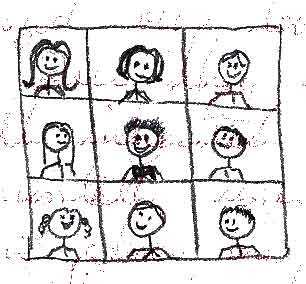
It seems that changing our minds is harder than we think, but only because we refuse to do so. A
new study is suggesting that misinformation isn't just a result of government propaganda or media manipulation; people just get attached to what they think they know.
Pictured left: person attached to a false belief.
Human reasoning is not a perfect system (surprise!), and without careful supervision our minds can get caught in belief ruts that eventually disconnect us from reality. Many of us think that human reasoning operates in a fashion that scientists call "Bayesian updating," meaning that we incorporate new information into what we already know and change our minds accordingly.
The researchers behind a new study, published in the journal
"Sociological Inquiry," beg to differ. They see human critical processes as a system they call "motivated reasoning," where people "ignore challenging information altogether, discredit the information source, or argue substantively against the challenge" when faced with contradictory ideas.
The new study is taking a closer look at how people (voters in particular) handle information that relates to things they erroneously believe. The researchers interviewed individuals about the notion that Saddam Hussein had something to do with the 9/11 attacks, a relationship that has been officially negated by the CIA, the Senate Intelligence Committee, and eventually Bush himself, but remains popular for some reason.
So why do polls continue to show that people think there was a direct relationship between al Qaeda and Hussein? The findings of this study have much to say about human reasoning in general, and force us to reconsider some of the beliefs we stubbornly hold.
Polls continue to show that a significant portion of the US population holds the false belief that Saddam Hussein was directly or significantly to blame for the attacks of 9/11.
The study included interviews of various people who claimed they believed that Saddam Hussein was either partly or largely responsible for the attacks on 9/11. The researchers then presented the participants with evidence pointing to there being no relationship. Despite having the facts in their hands, including a quote from Bush himself saying that there was no relationship between Hussein and al Qaeda, all but one person insisted that the relationship must exist.
There were a few acts of mental gymnastics that the researchers noted among the participants that refused to change their minds. If any of these methods seem familiar, don't be surprised; they're ways that we all occasionally cope with cognitive tension, the name that scientists give to the discomfort that we feel when our view of reality is challenged.
One way participants handled the new information was through "counterarguing," or by disputing the facts themselves. One participant argued that there's not going to be evidence of a link between Hussein and al Qaeda because it's all very secretive. At least the believers in this category have a reason, but they are the exception.
The most popular strategy was "attitude bolstering," where the participants switched from answering the question of the link between Hussein and al Qaeda to other reasons that the Iraq war is justified. These participants answered that Saddam Hussein needed to be dealt with eventually anyway, or that Bush thought there were WMDs to worry about.
A third option was "selective exposure," where the new information was dismissed or brushed off. The participants refused to comment on it or consider it.
Study participants had various strategies for retaining their false beliefs in the face of contradictory evidence.
A fourth way that participants maintained their positions was by "disputing rationality." These believers did not produce a reason for continuing to believe, but maintained that they had their own opinions.
Finally, participants surprised the researchers by creatively justifying their belief through "inferred reasoning." These participants used a backward chain of reasoning to argue that there must be a reason that we went to war with Iraq and remain at war with Iraq, and that reason must be because Saddam Hussein was responsible for 9/11.
While it's easy to criticize, it's best to take this information and use it to assess your own thinking. Without vigilance and honest self-analysis, it's all too easy to get caught up in these types of justifications when something we personally want to believe is challenged. But being open-minded means being able to consider new information and critique your own mind. It's not always easy, but it's the only way to get smarter.
Read the actual study,
"There Must Be a Reason: Osama, Saddam and Inferred Justification."
All drawing are (obviously) original creations and are the property of Zu's News. Images may not be reproduced without express permission from Zu's News, although you could probably just draw something better yourself.


























